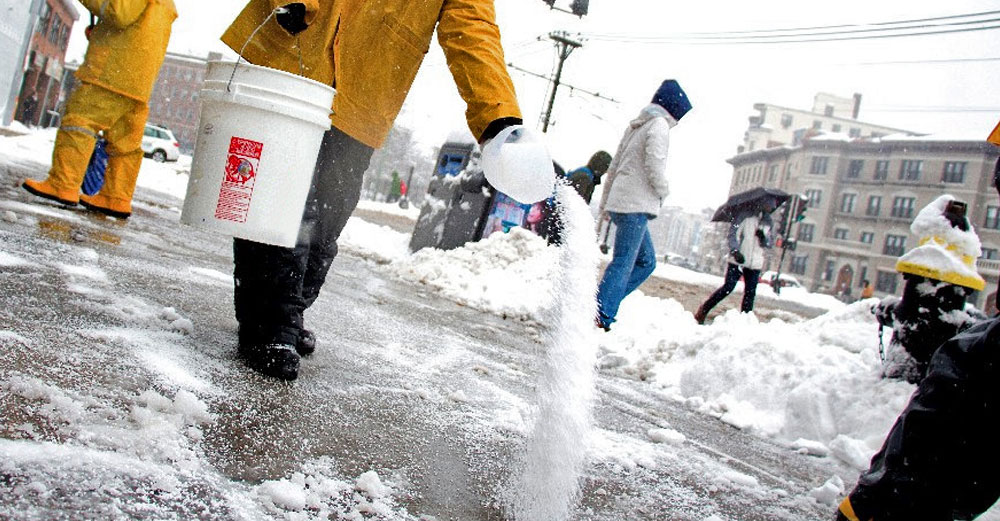
Picture this. It is 8:30 am and you are on your way to class. Coffee in one hand and cell phone in the other, you are making your way down the sidewalk from your dorm/apartment to that early morning class. You’re walking along, jamming out to the latest “it” song, when all of a sudden you feel your feet come out from underneath you and before you know it you are sitting on the floor with coffee all over your sweatshirt.
Whether you’re going to work or class, many of us have had an event similar to this happen at least once. Now that winter is in full swing, these unfortunate occurrences are becoming more frequent. So we asked an expert to give some advice to you all about the best way to treat icy sidewalks and some of the science behind the weather conundrum.
We asked Casey Raymond, an Associate Professor of Chemistry and Geochemistry at SUNY Oswego to breakdown the science of ice/snow management for those of us who don’t study in that field.
 Name: Casey Raymond
Name: Casey Raymond
Capacity: Associate Director of Honors Program; Associate Professor of Chemistry and Geochemistry
Campus: SUNY Oswego
Question: What’s the best way for me to treat sidewalks to remove ice and snow in the winter?
Answer: Professor Raymond said
“treating slippery sidewalks or drives in the winter can take two approaches. One of these simply involves putting something on the surface to provide traction. Typically this is dirt, gravel, sand, or cat litter. These items can slightly warm the snow or ice to help melting, but this only happens if the materials are warmer than 0 °C (32 °F) and this effect is only temporary. However, these materials increase the friction between ice and tires or feet to minimize the chance of slipping. But too much of this can be just as dangerous: an overly thick layer can be like a bunch of marbles spread on the floor.
Also, many modern cat litters will make the slipping worse, especially the self-clumping versions. If you have ever cleaned a litter box containing these types of litter you’ll understand how the clumps can become very slimy and gooey. The only reason cat litters are talked about in this context is that many years ago litter was readily available, inexpensive, and could be stored indefinitely, so a bag thrown in the trunk of a vehicle could be there many years before it was used. A container of sand is a much better option.
The second approach involves adding something that dissolves in water. This takes advantage of colligative properties, which are are related to the amount of ‘stuff’ (molecules and ions) dissolved in a solution. One such property is the freezing point depression: solutions of ‘stuff’ dissolved in water have a lower freezing point than pure water (0 ºC, 32 ºF), and the more particles of ‘stuff,’ the lower the freezing point, so that water stays liquid rather than freezing into slippery ice.”
He gave us two options to help with the very real situation of sliding while walking or driving. The most common solution to ice is salt. Whether you salt your own sidewalks or the city does it for you, salt can always be found on the ground from December to February. However, there are a few drawbacks. Professor Raymond noted,
“many people dislike using salt because it can encourage corrosion, so other options have been developed. These include salts of calcium and magnesium ions, like calcium chloride and magnesium acetate. These salts can reduce the freezing point to –37 °C (–35 °F), so they are useful in colder weather than sodium chloride. Additionally, these salts can be less damaging to the environment than sodium chloride. Because of the potential environmental damage, many organizations are exploring alternative options, including using versions of sugar solutions.”
There are also some preventative measures you can take when a storm is imminent.
“Placing these salts or a solution of these salts on a surface before precipitation (snow) begins can more efficiently develop a barrier to ice forming on the surface. This is why you might see road crews spreading salt before the snow actually begins—this is a good thing. Many road crews actually use a combination of a salt and dirt/sand. The dirt provides “grip” immediately and gives the salt a chance to melt some of the snow into water and a lower freezing temperature solution. Individuals can easily make their own versions by mixing sand with their favorite ice-melting salt.”
There is a lot more that goes into protecting people from ice than one may have initially thought. Next time you see a snow storm is coming, try implementing one of these suggestions and see if it saves you from ending up with coffee on your clothes!




Great article. Another way to help keep sidewalks safer in the winter is to apply a concrete water repellent or concrete sealer. This will prevent the water from freezing within the concrete, leaving any frozen precipitation only on the surface. Ice on the surface is much easier to thaw naturally or with deicing solutions. Also, an added benefit to sealing the concrete will protect from corrosion caused by deicing chemicals or premature degradation caused by freeze/thaw cycling..